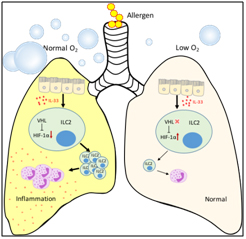Prof. Yun-Cai Liu’s Group Revealed New Mechanism for the Regulation of Innate Lymphoid Cells
Source:Yun-Cai Liu
2018-03-09
On February 14th, Prof. Yun-Cai Liu’s group from the Institute for Immunology, Tsinghua University, reported in the journal Immunity about the mechanism of oxgen-sensing pathway in the regulation of group 2 innate lymphoid cells (Li, Q., et al., E3 ligase VHL promotes group 2 innate lymphoid cell maturation and function via glycolysis inhibition and induction of Interleukin-33 receptor. Immunity. 2018. 48(2): p.258-270.).
Group 2 innate lymphoid cells (ILC2s) are key players in innate immunity, which mediate type 2 immune responses and are critically involved in allergic diseases such as asthma. However, the mechanisms of their regulation remain unclear.
Using an acute lung inflammation model induced by papaya protein papain, Prof. Liu’s group found that conditional knockout of E3 ligase VHL in ILC progenitors resulted in decreased ILC2 numbers in the lung and significantly impaired ILC2-mediated type 2 airway inflammation. They further discovered that VHL depletion resulted in accumulation of its target oxygen-sensing protein HIF1a, which led to enhanced glycolysis and attenuated oxidative phosphorylation, thus changed the epigenetic modification on the gene encoding IL-33 receptor on ILC2s. As the consequence, ILC2 maturation was blocked and thus accounted for their absence in the peripheral tissue such as the lung. The new work suggests that manipulation of glycolytic pathway could be useful to treat allergic diseases.

Dr. Qian Li, a postdoctoral fellow, Ms. Dulei Li and Ms. Xian Zhang, two graduate students, are the co-first authors of this paper. This work was supported by funds from the Natural Science Foundation of China, Ministry of Science and Technology of China and the Tsinghua-Peking Center for Life Sciences.
Full citation: https://doi.org/10.1016/j.immuni.2017.12.013
Group 2 innate lymphoid cells (ILC2s) are key players in innate immunity, which mediate type 2 immune responses and are critically involved in allergic diseases such as asthma. However, the mechanisms of their regulation remain unclear.
Using an acute lung inflammation model induced by papaya protein papain, Prof. Liu’s group found that conditional knockout of E3 ligase VHL in ILC progenitors resulted in decreased ILC2 numbers in the lung and significantly impaired ILC2-mediated type 2 airway inflammation. They further discovered that VHL depletion resulted in accumulation of its target oxygen-sensing protein HIF1a, which led to enhanced glycolysis and attenuated oxidative phosphorylation, thus changed the epigenetic modification on the gene encoding IL-33 receptor on ILC2s. As the consequence, ILC2 maturation was blocked and thus accounted for their absence in the peripheral tissue such as the lung. The new work suggests that manipulation of glycolytic pathway could be useful to treat allergic diseases.

Dr. Qian Li, a postdoctoral fellow, Ms. Dulei Li and Ms. Xian Zhang, two graduate students, are the co-first authors of this paper. This work was supported by funds from the Natural Science Foundation of China, Ministry of Science and Technology of China and the Tsinghua-Peking Center for Life Sciences.
Full citation: https://doi.org/10.1016/j.immuni.2017.12.013


